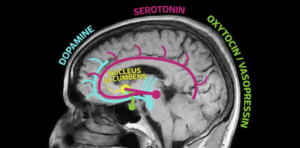Neurochemicals
 Remember your first joyful intimate kiss?
Remember your first joyful intimate kiss?
Wherever your first romantic encounter happened, the chances are you remember everything about it…the place, the smells, the taste, what you were wearing, the feeling of lips blending, the music playing and the sense of intimacy and hope for the future. It probably happened when you were a teenager. It’s fun to be romantic about that debut, but did you know it was cascades of neurochemicals in your brain that provided the experience?
It won’t take away from the mystery of love to know this, but it will help us understand why some emotions and experiences are so strong and form such lasting memories.
Pleasure Neurochemicals
So what happened back then? At the first glimpse of the object of our desire, our heart beat a little faster and we may have ‘glowed’ more or started to perspire. That was our arousal state firing up with adrenaline. The anticipation of the pleasure and reward that drove us to engage with someone new, was induced by the go-get-it neurochemical dopamine. Dopamine helps to embed the memory of an emotional event, especially if we keep thinking or talking about it. It drives motivation and craving. Learn more about dopamine in this science-based cartoon here. Teenagers produce more dopamine than adults or children and are more sensitive to it. (This video link is an interview with one of the experts who discovered the wanting and liking aspects of desire mediated by dopamine.)
The pleasurable sensations of the kiss and embrace themselves would have come from the flood of opioids in the reward centre that would have spurted just after the dopamine. So dopamine is about wanting and liking is driven by opioids. The wanting system is stronger than the liking system . This is why nature wants to keep us seeking and searching for the perfect ‘it’ , whatever ‘it’ we are seeking after. Again, as with dopamine, teenagers produce more opioids than adults or children and are more sensitive to it. Novelty is a huge driver for them.
Feelings of Intimacy
 The feeling of bonding and trust that comes when we let someone be close or intimate is from oxytocin. If you felt happy and content at the thought of having found a possible mate, it was probably induced by the increased levels of serotonin in the brain. It operates when we feel content or a sense of position in the social hierarchy, such as having found someone to love, the chance to be a couple. Any headache or pains would have disappeared as endorphins kicked in to mask the pain.
The feeling of bonding and trust that comes when we let someone be close or intimate is from oxytocin. If you felt happy and content at the thought of having found a possible mate, it was probably induced by the increased levels of serotonin in the brain. It operates when we feel content or a sense of position in the social hierarchy, such as having found someone to love, the chance to be a couple. Any headache or pains would have disappeared as endorphins kicked in to mask the pain.
You will have remembered this emotional event so well because, to your primitive brain, it was a life-changing event. It will have forged a strong memory pathway in your brain, reminding you of the pleasant feelings and encouraging you to repeat the behaviour again and again.
What happened next?
If your sweetheart got back in touch and wanted a date, your heart would have skipped a beat all over again along with the cycle of happy neurochemicals in anticipation of pleasure and your thoughts of a possible happy future together.
If however, he or she wasn’t really interested in another encounter, you would probably have produced cortisol, the stress neurochemical also linked to depression. Thinking non-stop in a manic way about the person or situation, what you/they did or didn’t do, may have resulted from the effect of low levels of serotonin. This is found in obsessive compulsive disorder too. Anger at the frustration of our goal or desire can lead to mental health impairments if we don’t learn to think differently about the situation.
Too much dopamine and not enough serotonin, the neurotransmitters of the brain’s “pleasure” and “happiness” pathways respectively, influence our moods. Remember however, that pleasure and happiness are not the same thing. Dopamine is the “reward” neurotransmitter that tells our brains: “This feels good, I want more and I want it now.” Yet too much dopamine signalling leads to addiction. Serotonin is the “contentment” neurotransmitter that tells our brains: “This feels good. I have enough. I don’t want or need any more.” Yet too little serotonin leads to depression. Ideally, both should be in optimal supply. Dopamine drives down serotonin. And chronic stress drives down both.
Learning to be content and not be seeking a constant ratcheting up of stimulation is a key life lesson to learn. So is learning to manage our thoughts, fantasies and emotions.
A book by Loretta Breuning called “Happy Habits of a Happy Brain” and her website provide a fun introduction to our happy and unhappy neurochemicals.
Photo by Tati y Adri on Unsplash

